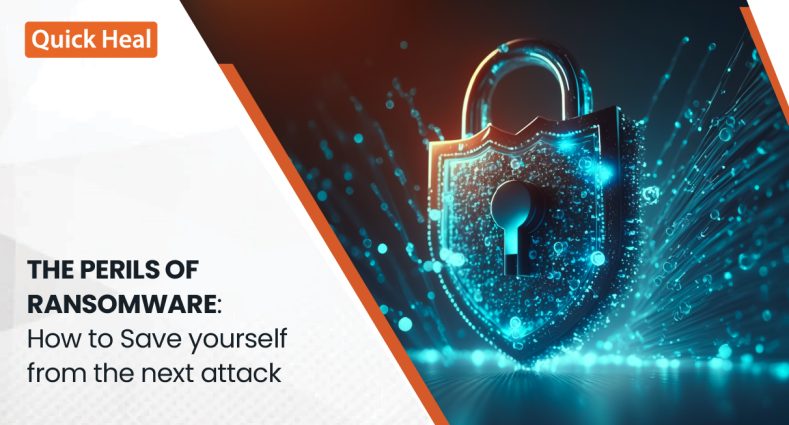THE PERILS OF RANSOMWARE : How to Save yourself from the next attack

In recent years, ransomware attacks have increased in frequency and sophistication, resulting in substantial impact across numerous industries and sectors worldwide. A typical ransomware attack encrypts computer systems, and blocks access to the user’s or company’s own data, and a ransom is demanded as payment in exchange of its release. In this blog, we will look into the increasing growth of ransomware attacks in different parts of the world, and dive deeper into understanding how such attacks are spreading rapidly. You will also learn what can be done in order to lessen the devastating impact of ransomware attacks.
How does a Ransomware Attack propagate?
Ransomware is typically spread through various infection methods, some of which include:
- Phishing emails: Phishing emails are a common way for ransomware to spread since they are designed to deceive recipients into downloading an attachment or clicking on a link. By doing this, they unknowingly download malware that infects their machines and starts spreading.
- Malicious Website & Malvertising: Cybercriminals use malicious websites and online advertisements to spread ransomware by taking advantage of flaws in web browsers and other softwares. When an unsuspecting user clicks on one of these ads or websites, their machine becomes infected and begins to distribute ransomware.
- Drive-by downloads: A drive-by download is when a user accesses a website that has been compromised, causing the ransomware to be downloaded and installed without the user’s awareness.
- Exploit kits: These are toolkits that attackers use to locate software flaws and exploit them in order to install malware. They can be used to disseminate ransomware.
- Remote Desktop Protocol (RDP) attacks: RDP assaults take place when hackers use stolen or shoddy credentials to obtain remote access to a network and deploy ransomware on numerous devices at once.
- USB drives: Infected USB drives that are placed into a computer can immediately install ransomware.
- Social engineering attacks: Attackers trick people into downloading and installing ransomware by using social engineering techniques. Attackers may, for instance, pretend to be reputable software vendors and lure customers into downloading a fake update that actually contains ransomware.
Worldwide Effects:
There have been many high-profile ransomware attacks in recent years. Here are some examples:
- Colonial Pipeline: In May 2021, a ransomware assault targeted the Colonial Pipeline, which supplies fuel to many parts of eastern United States. The attackers, who are thought to be members of the Dark Side ransomware group, requested a $4.4 million Bitcoin ransom. There was widespread fuel shortages and increase in fuel price as a result of this assault.
- A large cooperative bank in India: In 2018, a targeted ransomware attack resulted in the theft of nearly $13 million from one of the largest cooperative banks in India. A group of hackers operating in Canada were accused of carrying out the attack.
- Wipro: In 2019, a ransomware assault targeted against Wipro’s clients’ systems resulted in system failure. The North Korean hacker collective, Lazarus was accused of carrying out the attack.
- Bank of Maharashtra: In 2018, a ransomware assault caused the data in the Bank of Maharashtra to be encrypted. The assailants sought a Bitcoin ransom in return for the decryption key.
- JBS: The biggest meat supplier in the world, JBS, was the target of a ransomware attack in June 2021 that halted the production and supply of meat in Australia and North America. The attackers, who are thought to be a member of the REvil ransomware group, requested a $11 million Bitcoin ransom.
- Kaseya: Over 1,500 businesses globally were impacted by a ransomware attack in July 2021 that targeted the Kaseya VSA software. The attackers, who are thought to be a member of the REvil ransomware group, wanted $70 million in Bitcoin as ransom.
- Acer: In March 2021, a ransomware assault on Taiwanese computer maker Acer resulted in a demand for a $50 million ransom payment. The attackers, who are thought to be members of the REvil ransomware group, gained access to confidential business information and threatened to disclose it if the ransom was not paid.
- Toshiba: In May 2021, a ransomware attack affecting the European activities of the Japanese electronics manufacturer Toshiba resulted in a $34 million ransom demand.
Impact on Critical Infrastructure:
Critical services like healthcare, transportation, and energy are often targeted for ransomware attacks, which could lead to disruption of service and devastating consequences. Since hospitals and other healthcare facilities require quick access to patient data in order to deliver life-saving care, the healthcare industry is particularly susceptible to ransomware attacks. These attacks have the potential to cause injuries, fatalities, and high financial expenses. In short, attacks by ransomware have a major potential to affect the entire world, both in terms of financial loss and interruption of essential infrastructure and services. Here are a few instances of ransomware’s global effects:
- Financial losses: Both individuals and companies can suffer considerable financial losses as a result of ransomware attacks. Sometimes, victims are required to pay significant sums of money in order to recover their systems or data, and even then, there is no assurance that the attackers will grant access again.
- Disruption of critical services: Ransomware attacks have the ability to cause widespread turmoil and even put lives in danger by disrupting vital services like healthcare, transportation, and energy.
- Data theft and privacy breaches: Data that is confidential, or information that are of financial and personal nature are targets of ransomware attacks. It can often lead to Identity theft and other forms of deception which can cause serious harm to people and businesses.
- Global impact: Because ransomware attacks can spread rapidly across networks and infect systems in various nations, they can have a crucial global effect. This can make it challenging for law enforcement and security organizations to find the perpetrators and stop further harm.
- Loss of reputation: Attacks using ransomware can harm the image of both individuals and organizations, particularly if they are unable to restore their data or systems and must inform the public about the attack incurred.
What can you do to defend against Ransomware Attacks?
Protecting your personal and company data from being encrypted and held hostage by cybercriminals requires that you defend your system against ransomware attacks. Here are some crucial actions you can take to protect yourself from such malware attacks:
1. Keep software up-to-date: Make sure all of the software you use, such as your operating system, online browser, antivirus program, all the applications installed on your system have the most recent security updates and patches installed. Ransomware is frequently installed on computers that have weak, out-of-date software.
2. Use strong passwords: To prevent account hacking, use secure passwords and two-factor verification. Avoid using passwords that are simple to predict, like “password” or “123456.”
3. Use antivirus software: To identify and stop ransomware threats, install antivirus software and keep it up to speed.
4. Backup your data: Your vital data should be regularly backed up to an external hard drive or a cloud storage platform. This backup should ideally be saved on an independent network or a different server to safeguard it. In the event that ransomware encrypts your data, you will be able to retrieve it from this backup.
5. Be cautious of email attachments and links: Never click on links from unidentified or dubious sources or open email attachments. Phishing emails are a common tactic used by cybercriminals to get victims to download malware or divulge login information.
6. Limit access to sensitive data: Access to sensitive information should be restricted to those who truly need it. By doing this, ransomware attacks will be less likely to spread to crucial files and folders.
7. Educate yourself and your staff: Stay informed and keep your staff updated about ransomware. Educate them on how to detect and prevent such attacks. Employees should receive due training on safe computing procedures, including minimizing threats of ransomware by NOT clicking on shady sites or downloading unknown files.
Conclusion:
Attacks using ransomware are evolving rapidly, and have the potential to majorly impact different industries worldwide. However, we can lessen the aftermath of these assaults, and reduce their occurrence by being aware of their dissemination techniques, and by putting strong cybersecurity measures in place. As cyber threats continue to grow, it is crucial to remain aware and proactive on our part.
Subject Matter Expert:
Mangesh Bhasme



No Comments, Be The First!